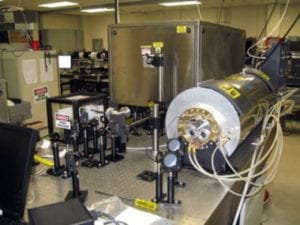A new remote sensing technology has recently been developed that will allow researchers to detect toxic gases up to one kilometre away.
The new technology can discriminate one type of gas from another with greater specificity than most remote sensors — even in complex mixtures of similar chemicals — and under normal atmospheric pressure, something that wasn’t thought possible before. The researchers say the technique could be used to test for radioactive by-products from nuclear accidents or for remote monitoring of smokestacks or factories for signs of air pollution or chemical weapons, for example.How it works
The technique uses a form of invisible light called terahertz radiation, or T-rays. Zapping a gas molecule with a terahertz beam of just the right energy makes the molecule switch between alternate rotational states, producing a characteristic absorption spectrum “fingerprint,” like the lines of a bar code. Terahertz sensors have been used for decades to identify trace gases in the dry, low-pressure conditions of interstellar space or in controlled conditions in the lab, but until now, efforts to use the same technique to detect trace gases under normal atmospheric conditions have failed because the pressure and water vapour in the air smears and weakens the spectral fingerprint.Why it works
In a study published in the journal Physical Review Applied, Everitt, Ohio State University physicist Frank De Lucia and colleagues have developed a way around this problem.Their approach works by blasting a cloud of gas with two beams at once. One is a steady terahertz beam, tuned to the specific rotational transition energy of the gas molecule they’re looking for.
The second beam comes from a laser, operating in the infrared, which emits light in high-speed pulses. Normal atmospheric pressure still blurs the chemical “bar code” produced by the blast of the Terahertz beam, but the ultra-short pulses of light from the more powerful infrared laser knock the molecule out of equilibrium, causing the smeared absorption lines to flicker. “We just have to tune each beam to the wavelengths that match the type of molecule we’re looking for, and if we see a change, we know it has to be that gas and nothing else,” concludes Everitt.







